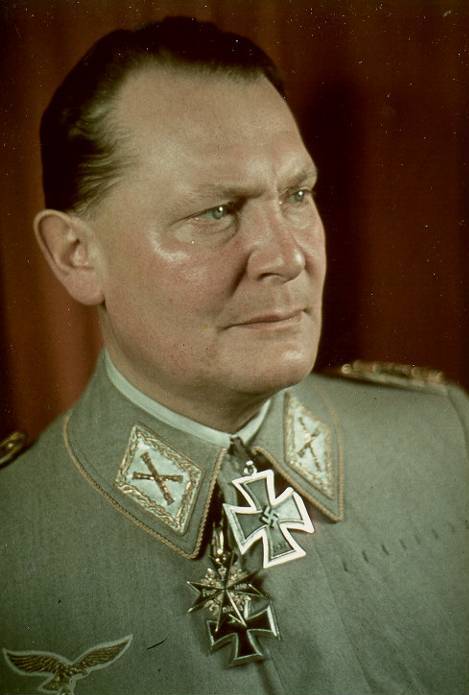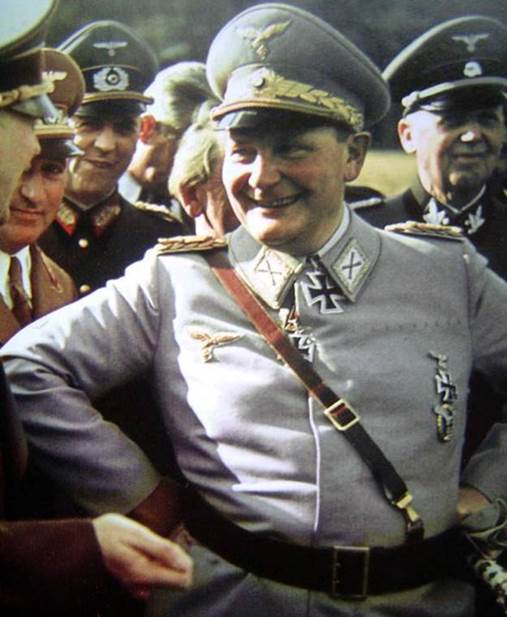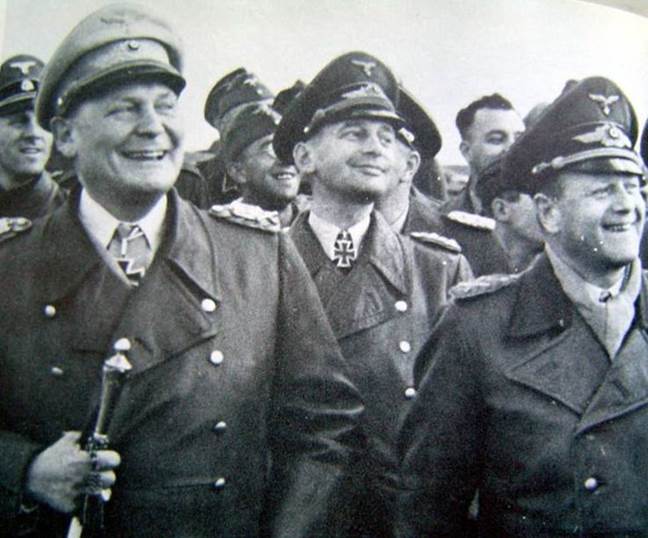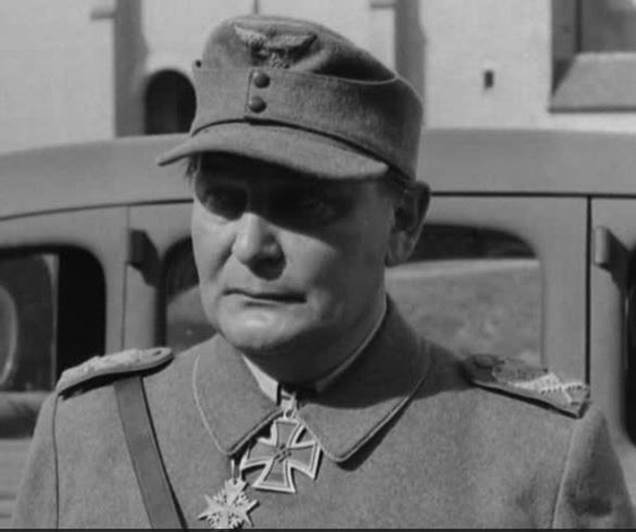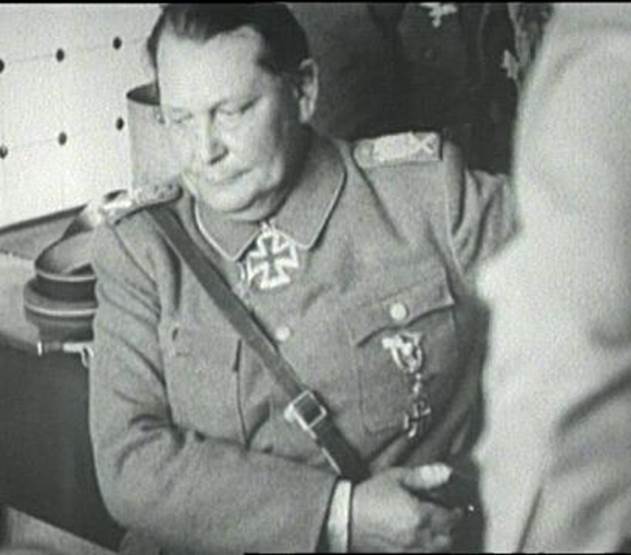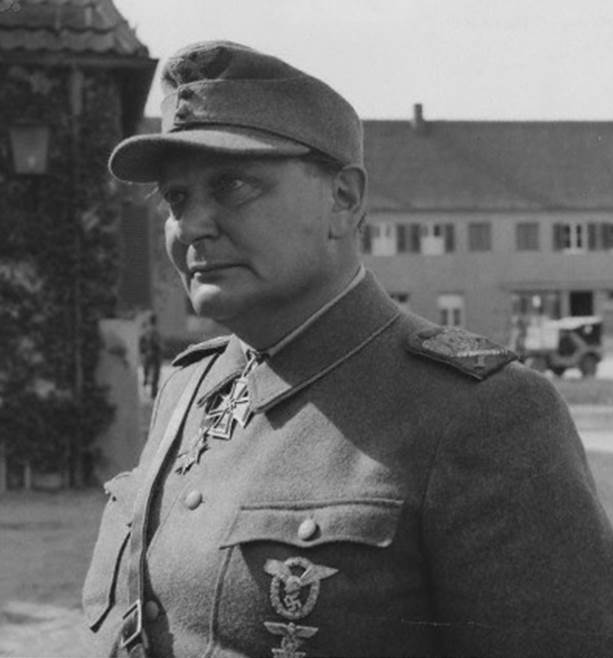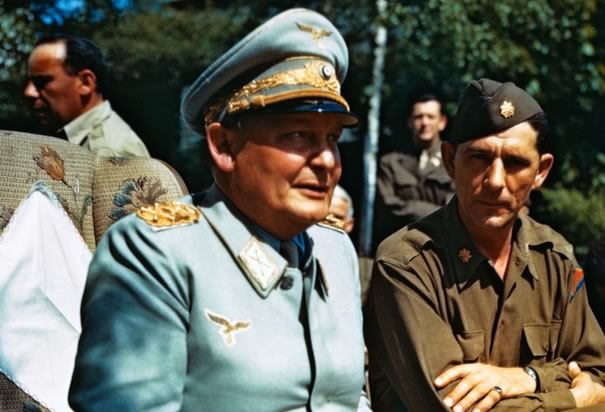General Officer Rank Insignia
WW2
Reichsmarschall Goring:
|
One of the more interesting figures in
the Third Reich was Hermann Goring.
He was a man obsessed by regalia and decorations. Goring is said to have changed uniforms
five to six times a day and period photos show numerous variations on every
uniform style that he wore. When
appointed by Hitler to the rank of Reichsmarschall in July of 1940, Goring
became the highest ranking military officer in the Third Reich, the
equivalent of a six star General.
With the new rank, came new insignia, and the new insignia designed
was as grandiose as its recipient. From period photos there is evidence that
Goring’s Reichsmarschall insignia evolved through three different variations. The earliest and last variations I do
not have contemporary photos of original examples to show, as they are so
rare that I’ve never seen them “in the wild”. I do know of some that exist in
collections, but the owners do not wish to share photos of these examples
with the collecting world for fear of the details being copied. As such, we will have to deal with
looking at poor resolution period photo close-ups to get an idea of what this
insignia looked like. |
Shoulderboards
|
|
|
First Pattern The very first pattern of shoulderboards
that Goring had produced to reflect his new rank was rather crude in
comparison to what was developed to replace it. The insignia attached to the boards
was very flat with little relief and consisted of an eagle with outstretched
curved wings, clutching a swastika with a pair of crossed field marshal
batons beneath. As I’ve
never seen or examined an original example, I’m not sure exactly what
this device was constructed of.
It would appear from the smooth surface of the swastika that it may
have been made from metal, but this is pure speculation based on the fact
that all ciphers, pips and batons on shoulderboards
were always made from either a silver or gold metal, depending on rank
grade. It also appears that the
base shoulderboard is constructed of three
interwoven gold cords, similar to both field marshal rank and the second
pattern Reichsmarschall boards. (period press photo) |
|
|
|
Second
Pattern These are the shoulderboards
most commonly associated with Goring and his Reichsmarschall rank and worn
throughout the duration of his career.
It consists of large, wide interwoven gold cords over a white
underlay, with a gold metal Wehrmacht eagle clutching a swastika, with the
crossed batons now positioned underneath the wreath. Even though a final, Third Pattern of
cloth embroidered shoulderboards were developed
(see below), Goring was still seen wearing this pattern at times after his
capture when he wore his standard light grey Reichsmarschall uniform for the
cameras during his interview with the Press. (private collection) |
|
|
|
Third Pattern This third and final pattern of shoulderboards
were actually shoulder straps and were first noticed in wear sometime late in
1944. The straps were designed in
a more subtle fashion in what was thought to be an attempt to look more like
his soon-to-be captors, the Allied forces. The straps were meant to be worn as
the only insignia on a very Spartan looking new uniform more suited to wear
in the field. The base straps
were a grey cloth slip-on strap, piped in gold with the Reichsmarschall
insignia hand-embroidered in gold. (example shown is a modern copy) |
Collar Tabs
|
|
|
First Pattern
Pair The first pattern of collar tabs Goring wore with his new
uniform consisted of two separate designs. On his right collar was a Wehrmacht eagle
with wings folded downward clutching a swastika. On his left collar was a pair of
crossed batons. This first
pattern pair of collar tabs were worn with both the first pattern shoulderboards and for a short time the second pattern shoulderboards.
It appears from examination of period photos that the crossed batons
on the left collar tab were of the same pattern and design of the second
pattern collar tabs, which are shown below. I have seen contemporary photos
published in books of alleged original examples of first pattern collar tabs
with crossed batons which look different and more crude. Until further examples of clear period
photos substantiate these examples, the question will remain unanswered as to
whether they are indeed early examples. (examples shown are modern copies) |
|
|
|
Second
Pattern The second and final pattern of collar tabs worn by Goring
as Reichsmarschall were mirror images and each had a pair of crossed batons. (private collection) |
|
|
|
Reichsmarschall
Here is another example that shows in close up detail the
very high quality of Reichsmarshcall insignia.
There is a finely detailed gold bullion embroidered laurel wreath surrounding
highly detailed, gold crossed marshals batons over a
silver brocade fabric. (private collection) |
Period Photos of the Insignia in Wear
The First Pattern Insignia
|
|
|
A press photo of Goring’s overcoat, lying on the seat of his car, displaying the new Reichsmarschall insignia, first pattern boards. |
|
|
|
A cropped version of the photo showing the details of the early, first pattern shoulderboards and devices. |
|
|
|
Here is another period press photo produced to announce the Reichsmarschall’s new rank insignia. This is yet an even different version eagle than the first pattern shown above on the leather coat. Notice how short the eagle wings are, that they do not arch downward and that there appear to be five sun rays emanating from behind the eagle. The crossed batons also appear to be a bit different, much flatter with an outline. |
|
|
|
A surviving example of the first pattern device. |
|
|
|
Reichsmarschall Goring, wearing his new insignia at the coast during the early days of the Battle of Britain. Notice how Goring is wearing a blue-grey Luftwaffe tunic and has yet to have designed his iconic light grey Reichsmarschall uniform. Notice also the very distinct first pattern shoulderboards that lay flat. It’s possible these are the above very early style boards (perhaps we should call these the pre-first pattern?) with the wings that don’t turn downward. Also notice the batons on his left collar tab and how distinct and thin the crossed batons are, supporting the speculation that the crossed baton tabs were the same as the second pattern tabs. Notice also the eagle tab on his right collar and the fact that he doesn’t wear a breast eagle. |
|
|
|
In this photo (from the same series as the above photo) we can see a clearer view of his right side eagle collar tab, as well as how thin the first pattern shoulderboards are. |
|
|
|
This photo shows us a nice, clear aerial view of one of his first pattern boards. Notice how wide the curved wings of the eagle device are, in that they look to extend to the edge of the cords and beyond. |
|
|
|
Another image from the same day with a clear view of the early shoulderboards worn with his blue-grey uniform. |
|
|
|
A closer view of the above photo. |
|
|
|
In this interesting photo, we see Goring in an overcoat with first pattern shoulderboards and collar tabs. Notice again how thin and flat the first pattern shoulderboard devices are. The bright gold embroidery of the collar tabs is reflected even in the soft light of the day. |
|
|
|
Goring in a white tunic with the early insignia. |
|
|
|
At this stage, we see that Goring has now begun to wear his unique and iconic light grey Reichsmarchall uniform and visor cap, yet retains the first pattern shoulderboards. |
|
|
|
A formal portrait of Goring in his new Reichsmarchall uniform, with first pattern shoulderboards and collar tabs. |
The Second Pattern Insignia
|
|
|
Goring in a white tunic, now wearing the second pattern collar tabs and shoulderboards. Both are easy to spot in photos, as the collar tabs now both have the crossed batons, and the shoulderboards have the thick metal second pattern devices attached, which give the shoulderboards much greater vertical height. |
|
|
|
Goring in his trademark light grey uniform. In this example we can clearly see the large, thick second pattern devices on his shoulderboards. Notice the full embroidered wreath around the cap band….just one of his variations in headgear. |
|
|
|
An excellent, detailed view of the second pattern collar tabs and of course the thicker shoulderboard devices. Notice this photo has been flipped, as the breast eagle is on the wrong side of the tunic. |
|
|
|
Another clear, detailed image of the collar tabs. |
|
|
|
Again, a nice view of the thickness of the second pattern boards. |
|
|
|
This is a photo I use to illustrate a point in another section of the website. Goring wearing the second pattern shoulderboards on his leather coat. Notice that the boards were put on backwards (the button loop should be towards the back, not the front). Again, you can clearly see the thick, metal second pattern devices. |
The Third Pattern Insignia
|
|
|
Goring wearing his third and final pattern of insignia on the day he surrendered to U.S. troops. Notice the embroidered second pattern emblems on his cloth shoulder straps. This very plain, unique uniform has been referred to as his “utility” uniform and his “grey” uniform. |
|
|
|
Another view of this unique uniform and insignia. |
|
|
|
Another photo during his surrender, where we can see some of the detail more clearly. Notice the heavier wool texture of the uniform and hat, more of what you would expect for field wear, yet the shoulder straps are an obvious giveaway that this is no ordinary field soldier! |
|
|
|
An image from a filmed press interview with Goring after his surrender, in which he had switched from his utility uniform with third pattern field insignia back into his more familiar and recognizable light grey Reichsmarchall uniform with second pattern insignia. |
|
If you’d like to learn more about
Hermann Goring’s various uniforms and regalia, I’d highly
encourage you to pick up the following books which are excellent resources; “Uniforms
and Traditions of the Luftwaffe, Volume II” by John Angolia
and Adolf Schlicht “Uniforms
and Insignia of the Luftwaffe, Volume 2: 1940-1945” by Brian L. Davis Both books devote entire chapters to
Hermann Goring’s uniforms, insignia and headgear. Highly recommended! |






















